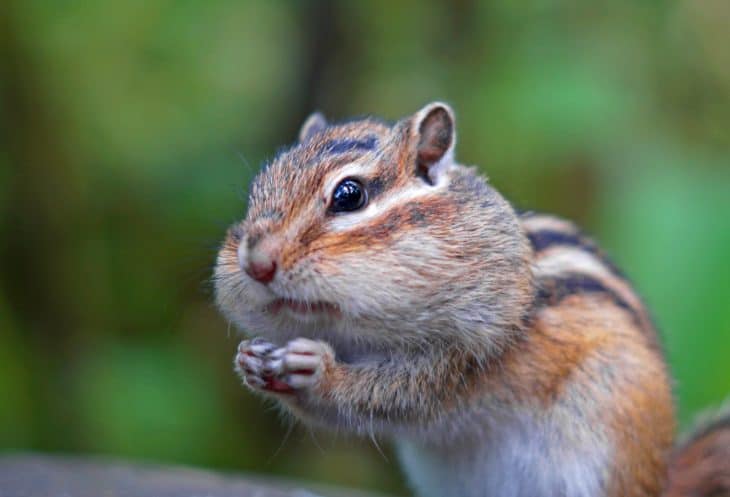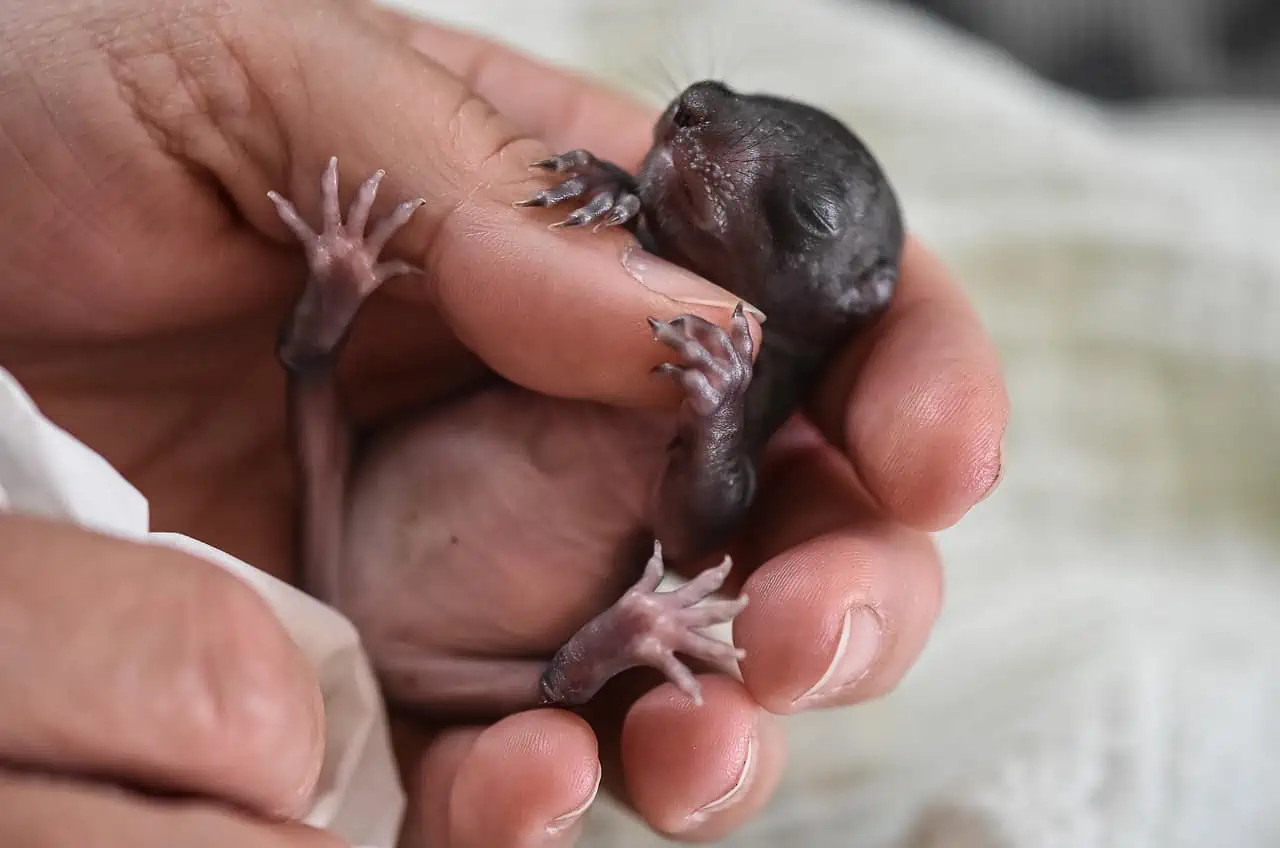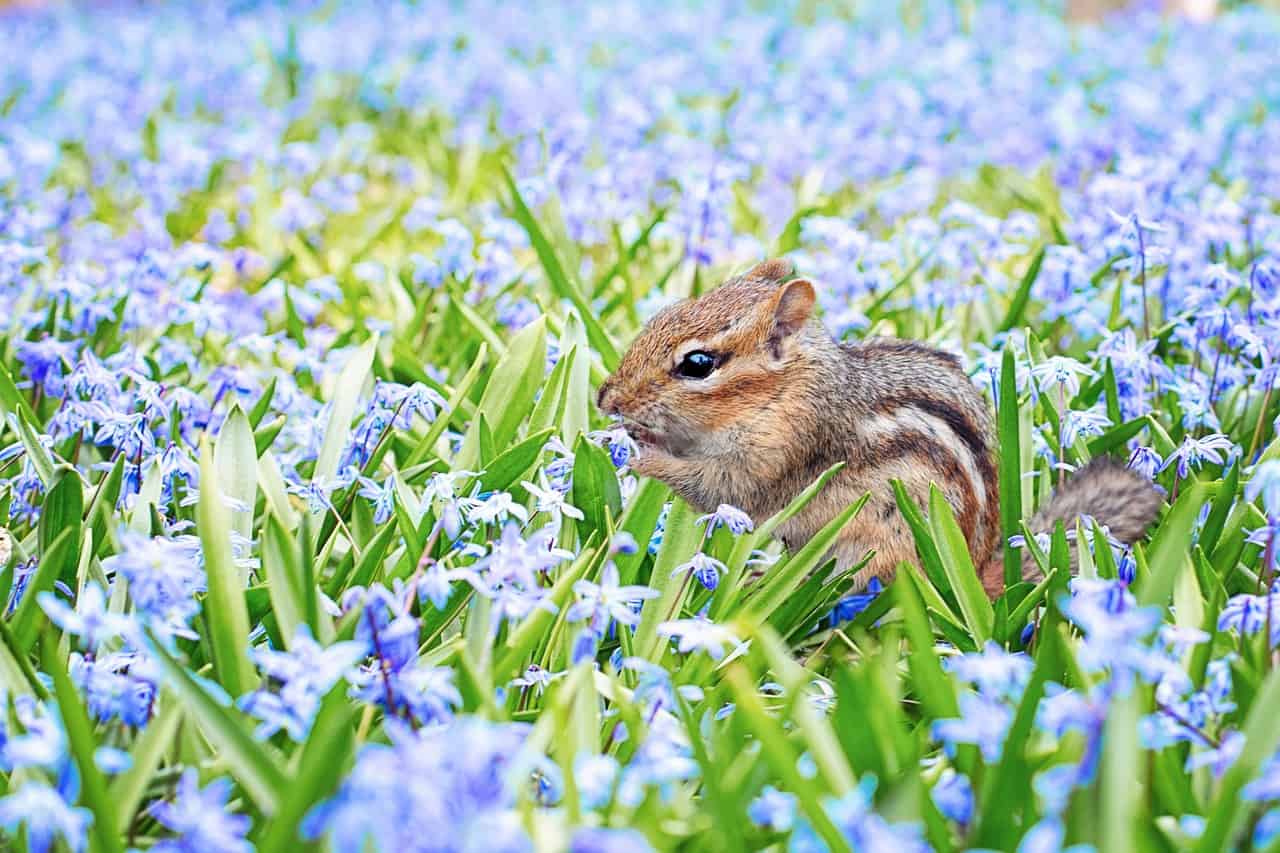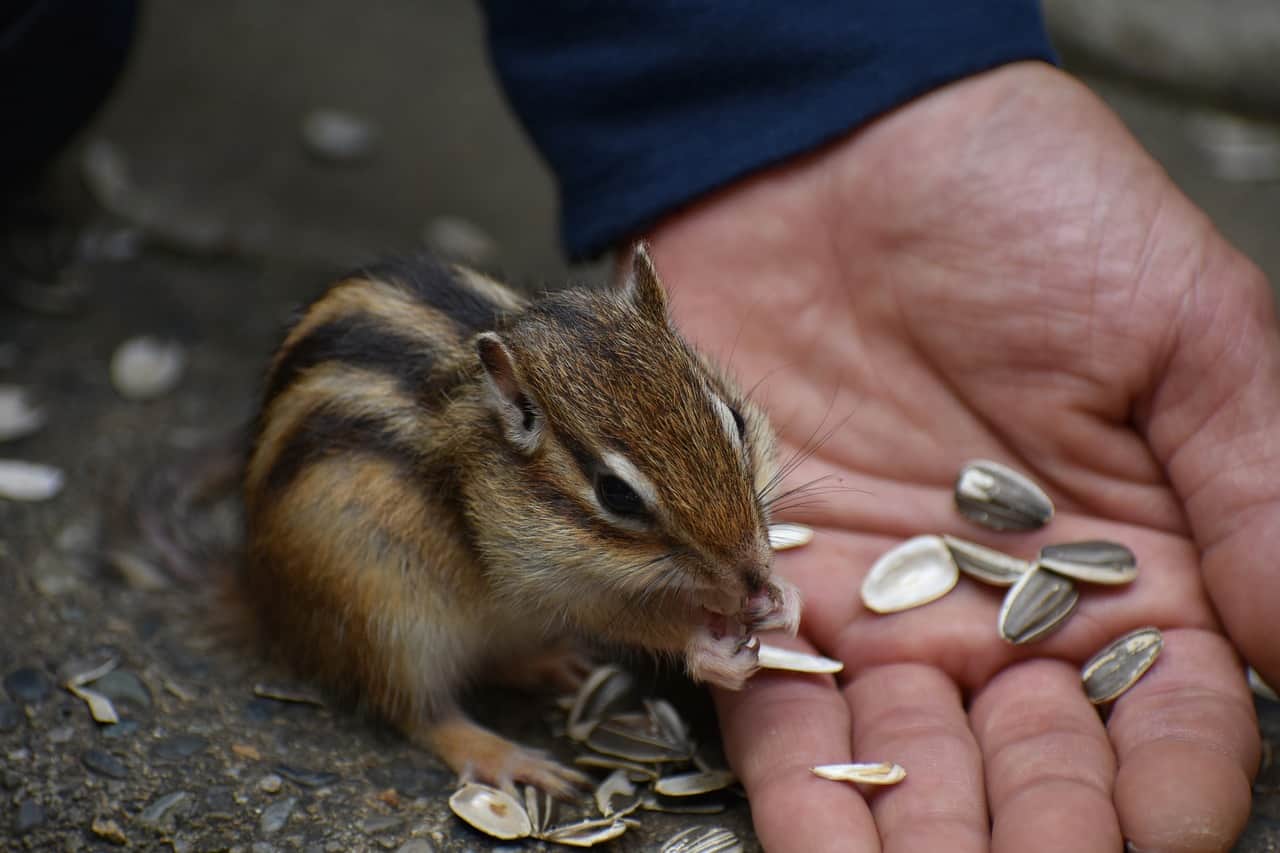
Zippy and lively critters, chipmunks are the smallest member of the Sciuridae or the squirrel family. You may have seen these tiny creatures scampering in your yard, collecting their favorite nuts. Or maybe you learned more than a few chipmunk facts in your biology class when you were a student.
Like most people, chances are, you got introduced to the world of chipmunks via the “Chipmunk Christmas Song” (Christmas Don’t Be Late), a novelty song sang by Alvin, Theodore, and Simon, the cartoon chipmunk brothers introduced by Disney. Or maybe you never missed an episode of the famous Chip ‘n’ Dale cartoon series as a kid!
If that’s the only exposure you’ve had to chipmunks, you might have missed out on a few important details. After all, not all animated animals look like their real-life counterparts. Yes, chipmunks are as adorable as can be, with their cute features, bushy tails, striped backs, and chubby cheeks. When you see one, you want to bring one home and have it as a pet.
However, these charming creatures are more than just their looks. There are many things to learn from them. For instance, how they hunt for food, their subterranean form of living, and how their dietary habits help the environment are factors that will definitely amaze you.
So go ahead and learn more about fun and exciting animals. Check out our chipmunk facts list below.
- There are 25 species of chipmunks.
- Their tails are usually 3 to 5 inches or 7 to 12 centimeters long.
- Chipmunks weigh around 1 to 5 ounces or 28 to 141 grams.
- Generally, a chipmunk’s body is from 8 to 16 centimeters or 3.1 to 6.3 inches.
- Typically, they live for around 3 years in the wild and up to 9 years in captivity.
- Chipmunks are tiny striped rodents.
- Chipmunks are from the Sciuridae or squirrel family.
- Tamias is the scientific name of the chipmunk.
- Originally, the chipmunk is spelled as chitmunk.
- The name chipmunk originated from Odawa. This is a dialect spoken by the Ottawa people. “Chipmunk” came from the word jidmoonh which means “red squirrel.”
- Chipmunks are also called “striped squirrels”, “timber tigers”, “minibears”, and “ground squirrels.”
- The eastern chipmunk hibernates during winter.
- A scurry is a group of chipmunks.
- Chipmunks are mammals.
- Chipmunks have four toes in their front paws, and five toes in their back paws.
- Chipmunks have special pouches on their cheeks that can expand three times the size of their head.
- When chipmunks sleep, their heart rate declines from 350 beats per minute to about 4 beats per minute.
- A chipmunk can gather around 165 oak nuts a day.
- Chipmunks can run at a speed of 33 kilometers per hour.
- Chipmunks are solitary animals, they spend most of their time collecting and storing food.
Chipmunks consume a variety of food.
Chipmunks are omnivorous. They primarily feed on seeds, fruits, nuts, and buds. Moreover, chipmunks also eat grass, shoots, and other forms of plants, along with fungi, small frogs, bird eggs, and worms. Occasionally, chipmunks can eat newly-hatched birds. They climb trees to get oak nuts and hazelnuts.
Siberian chipmunks primarily live in Asia.
The Siberian chipmunk is the only species that live outside North America. Their habitat ranges from northwestern Russia all the way to Japan, China, and Siberia. Typically, Siberian Chipmunks have five dark stripes and four white stripes along the back. They are relatively small compared to other species of chipmunks as they weigh only around 50 to 150 grams.
Baby chipmunks are born blind.
A litter of two to eight baby chipmunks is born after a 30-day gestation. Baby chipmunks, also called kits, kittens, or pups are born hairless and blind. They usually live with their parents for around two months before they live on their own.

Chipmunks live in holes or burrows.
Chipmunks dig extensive burrows that are more than 3.5 meters or 11 feet in length. These burrows have several hidden entrances. Moreover, they keep their dens clean and they have separate chambers where they store their feces and urine. Chipmunks also inhabit different types of environments like meadows, dry scrublands, while others also live in nests, logs, and bushes.
You can easily differentiate a chipmunk from a squirrel.
Ever wonder how to distinguish a chipmunk from a squirrel? Squirrels are larger, and don’t have stripes, except for the ground squirrel that has stripes but only on its head. A chipmunk has distinct stripes on the head, back, and tail.
Bigger carnivores prey on chipmunks.
Bigger carnivores are potential threats to chipmunks. They are a food source to several predators like snakes, hawks, rats, owls, coyotes, weasels, bobcats, raccoons, and even domestic cats. To avoid being eaten, chipmunks usually stay close to their home and are vigilant when they hunt for food.
Eastern chipmunks have fewer teeth.
Eastern chipmunks commonly live in woodland areas and urban parks in southern Canada and the eastern United States. Their upper body has reddish-brown fur, and they have lighter-colored fur on the lower part of the body. Similarly, eastern chipmunks have yellowish-brown stripes from their whiskers to below their ears. They also have fewer teeth compared to other chipmunks.
Chipmunks are diurnal.
Chipmunks are most active in the early morning and late afternoon. They usually take naps during the day before they search for food. Chipmunks work best during the daytime; they detect better when it’s still daylight. On the other hand, chipmunks in captivity sleep for around 15 hours a day.

A chipmunk's poop is similar to mouse droppings.
Chipmunks’ poop is similar to other rodents and squirrels. They are elongated, hard, and look like rice beans. Their feces measure around 1/2 to 3/4 inches and are a little smaller than the poop of mice. Over time, the poop of chipmunks hardens and becomes brittle.
Tamias minimus is the smallest chipmunk.
Tamias minimus is the name of the smallest species of the chipmunks. They have three dark and two light stripes on their face, while their sides have four light stripes. It measures 185 to 222 millimeters or 18 to 2.2 centimeters and weighs 42 to 53 grams or 1.48 to 1.86 ounces.
Chipmunks are rarely aggressive.
Chipmunks often run to the forest when they’re threatened. They also warn other chipmunks to stay in their burrows. However, if cornered, chipmunks may bite and scratch to defend themselves.
Chipmunks make chirping sounds.
Chipmunks make two common sounds. They make the “chip-chip” or a high-pitched sound similar to a bird call, to communicate if they sense a ground predator like cats or foxes. Meanwhile, if there are flying predators, chipmunks produce the “cluck-cluck,” or a sound similar to how a drumstick strikes into a hollow wood. Cute chipmunk facts!
Peanut butter can bait chipmunks.
It is important to use proper bait to trap chipmunks. Do you know that chipmunks love peanut butter? Chipmunks also enjoy nibbling on a morsel of cheese, eating unroasted nuts, prune pits, corn, sunflower, popcorns, and cereal. In snaring chipmunks, make sure to put the bait near, in, and on the trap. The aroma of the food will surely draw them for capture.
Peppermint oil can keep the chipmunks away.
There are different ways to get rid of chipmunks without poisoning or killing them. Chipmunks can’t stand the scent of strong oil like citrus, peppermint, eucalyptus, and cinnamon oil. Along with this, chipmunks also hate the smell of garlic and hot pepper.
A male chipmunk can inflate their vocal sac.
A male chipmunk is called a buck, while a female is referred to as a doe. In terms of size, males are somewhat smaller than females. Another way to determine their sex is through the chipmunk’s vocal sac. The vocal sac of male chipmunks inflate when they make sounds.
Chip and Dale are the chipmunks.
In 1943, the American multinational mass and entertainment company, The Walt Disney Company created Chip ‘n’ Dale. They are chipmunks known for their high-pitched sound, voracious appetites, and mischievous acts.
Dale can be identified with his large red nose, two adjacent front teeth, and knot of hair on his head. On the other hand, Chip has a black nose and fused front teeth. Chip and Dale had their first debut in a cartoon titled Private Pluto.
Alvin and the Chipmunks is the first live animated film of the animated franchise.
20th Century Fox released Alvin and the Chipmunks in 2007, which is the first of the live-action/computer-animated film featuring the titular trio. The movie was directed by American director and animator Tim Hill.
The film featured three chipmunk brothers: Alvin, Theodore, and Simon. Dave Seville, played by American actor and writer Jason Lee, is a struggling composer who discovers the chipmunks’ talent in singing.
You can watch it on Amazon here!
Chipmunks can be your pet.
Chipmunks can be good pets, and they are relatively clean animals. They groom themselves and do not require special baths. If you are going to get one as a pet, do take note that they need a spacious cage that will allow them to play, rest, and exercise.
It is not ideal to place a chipmunk in a cage that is less than 4 feet or 48 inches, and it is also essential to clean, wash and scrub their cage.

Palmer's chipmunk is a native of Nevada.
Palmer’s chipmunk only inhabits the Spring Mountains in Clark County, Nevada. They commonly live in forested areas and cliffs at around 7,000 to 10,000 feet in elevation.
The International Union for Conservation of Nature (IUCN) has classified Palmer’s chipmunks as endangered species. Woodcutting, extension of campgrounds, and animals that prey on chipmunks like dogs and cats are some of the factors that affect Palmer’s chipmunks’ habitats.
Chipmunks are beneficial to the environment.
Chipmunks are beneficial to the ecosystem. When they eat fungi, they help spread mycorrhiza, a fungus that helps increase water and nutrient absorption in plants. They also help flora flourish. By gathering and burying seeds, chipmunks aid in the spread of shrubs, trees, and other plants.
Was this page helpful?
Our commitment to delivering trustworthy and engaging content is at the heart of what we do. Each fact on our site is contributed by real users like you, bringing a wealth of diverse insights and information. To ensure the highest standards of accuracy and reliability, our dedicated editors meticulously review each submission. This process guarantees that the facts we share are not only fascinating but also credible. Trust in our commitment to quality and authenticity as you explore and learn with us.


